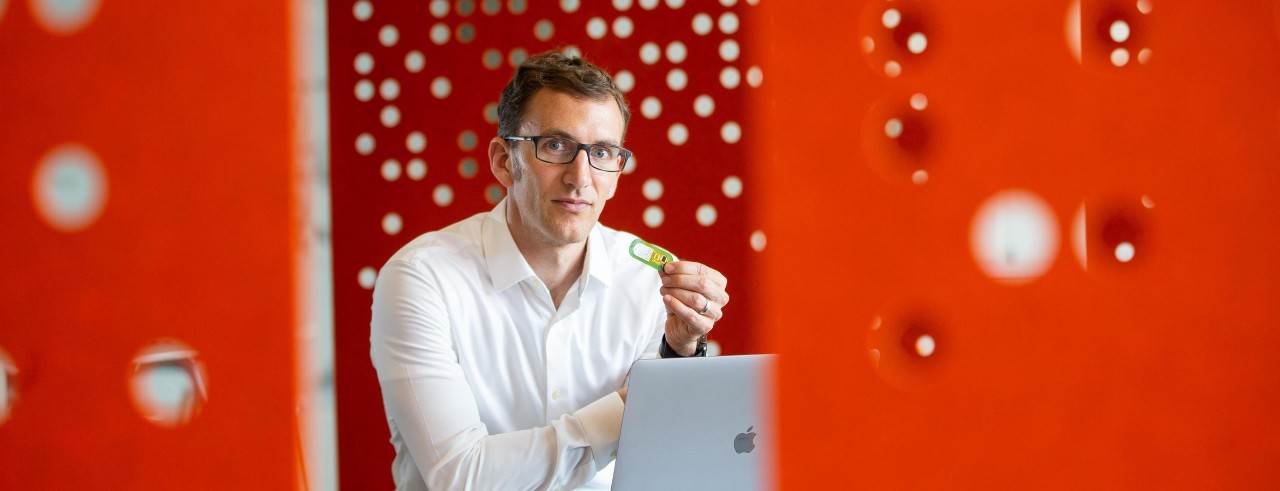
Getting under your skin for better health
Testing of interstitial fluid could one day replace bloodwork for health and wellness
The next frontier of continuous health monitoring could be skin deep.
Biomedical engineers at the University of Cincinnati say interstitial fluid, the watery fluid found between and around cells, tissues or organs in the body, could provide an excellent medium for early disease diagnosis or long-term health monitoring.
In a paper published in the journal Nature Biomedical Engineering, they outlined the potential advantages and technological challenges of using interstitial fluid.
“Why we see it as a valuable diagnostic fluid is continuous access. With blood, you can’t easily take continuous readings,” said UC doctoral graduate Mark Friedel, co-lead author of the study.
“Can you imagine going about your day with a needle stuck in your vein all day? So we need other tools.”

University of Cincinnati biomedical engineers say sensors that monitor interstitial fluid could be the next frontier for wearable technology. Photo/Mark Friedel
Researchers are looking for alternatives to monitor a person’s health and wellness. Sweat is a good medium for measuring certain things like stress or anxiety because it contains hormones such as cortisol. But the body is stingy with other chemicals that are not so easily released in sweat, Friedel said.
“Sweat glands are big filters that don’t allow everything to pass through,” he said. “So more than half of the things we want to monitor have no access to sweat at all.”
Blood is the gold standard for health monitoring. But people also have liters of interstitial fluid that make up as much as 15% of their body weight.
“The key feature of blood that makes it so advantageous is we understand blood really well,” Friedel said. “If you have something in your blood, we know what will happen to your heart or your liver,” he said.
Researchers said interstitial fluid contains many of the same chemicals in the same proportions as blood, offering a potential alternative to costly and time-consuming lab work.
The study outlined the various ways doctors can sample interstitial fluid, from applying suction to the skin to deploying microdialysis.
“As biomedical engineers, one of our greatest goals is to help people better manage their health by making diagnostics more accessible,” said co-lead author Ian Thompson at Stanford University.
“A big barrier to this accessibility is that most current diagnostics rely on blood sampling, which can be painful and requires trained personnel to perform. Thus, in recent years there has been growing interest in using interstitial fluid just under the skin as a diagnostic sample that is more accessible and less painful to extract.”
We’re trying to unlock the box and read the instructions inside to understand what’s in interstitial fluid and what the potentials are for exploiting it.
Mark Friedel, UC College of Engineering and Applied Science graduate
In UC College of Engineering and Applied Science professor Jason Heikenfeld’s Novel Devices Lab, students are developing sensors to measure hormones and other chemicals in interstitial fluid. They use microneedles less than 1 millimeter in length that pierce the skin through a tiny patch.
“If you had a splinter, it probably went deeper into your skin than our microneedles,” Friedel said. “They’re generally painless. I don’t feel it most of the time. The most uncomfortable part is removing the tape that holds the device down.”

UC graduate Mark Friedel co-authored a paper examining a promising alternative to blood for continuous health monitoring. Friedel said he wrote the research paper with one hand using his phone after breaking his collarbone last year. Photo/Andrew Higley/UC Marketing + Brand
But even if you don’t know it’s there, your body does, Friedel said. And this minute reaction can affect the test results.
“There’s a Schrödinger’s observer effect with interstitial fluid. Any time you try to collect and measure it, you inherently change the fluid itself,” Friedel said. “If you stick a needle in your skin, your body becomes inflamed and then your [sample] levels change. For continuous biomonitoring, we want to know those concentrations as they are when you’re not being poked with a tiny needle.
“That’s why it’s such a challenging fluid that hasn’t been used outside of diabetes monitoring.”
Still, researchers say, interstitial fluid holds enormous promise for monitoring health through wearable technology. This could help doctors track the efficacy of drugs to ensure proper dosage or provide early diagnosis of illness by monitoring the immune system.
But Friedel said there is still a lot to learn.
“We’re trying to unlock the box and read the instructions inside to understand what’s in interstitial fluid and what the potentials are for exploiting it,” he said.
UC's Friedel worked with co-author Heikenfeld, UC’s James L. Winkle College of Pharmacy, the Sandia National Laboratories in New Mexico and Southeast Missouri State University.
The study was funded through grants from the National Science Foundation, the U.S. Air Force Office of Scientific Research and the U.S. Office of Naval Research.
Featured image at top: UC College of Engineering and Applied Science professor Jason Heikenfeld and his students study wearable technology in his Novel Devices Lab. Photo/Andrew Higley/UC Marketing + Brand
Impact Lives Here
The University of Cincinnati is classified as a Research 1 institution by the Carnegie Commission and is ranked in the National Science Foundation's Top-35 public research universities. UC's graduate students and faculty investigate problems and innovate solutions with real-world impact. Next Lives Here.
Related Stories
Getting under your skin for better health
January 20, 2023
Biomedical engineers at the University of Cincinnati say interstitial fluid, the watery fluid found between and around cells, tissues or organs in the body, could provide an excellent medium for early disease diagnosis or long-term health monitoring.
UC research seeks to protect athletes from brain injuries
December 1, 2022
Former football players worry about the effects of concussions suffered during their playing careers and hope research from the University of Cincinnati will help them and future generations avoid the worst consequences of brain injuries. UC’s Office of Research hosted a panel discussion in the Flashpoint Series, “Brain Injuries in Sports: How we can help our athletes,” which addressed the effects of brain injuries and how research aims to develop solutions to protect athletes.
How to prevent concussions in football? Better helmets
March 6, 2023
Football helmets made by four leading manufacturers showed vulnerabilities in tests designed to better understand player concussions, according to a study by the University of CIncinnati.
UC Answers: How is UC using design to address COVID-19?
September 1, 2020
Claudia Rebola is an assistant professor and the associate dean for research at the University of Cincinnati’s College of Design, Architecture, Arts, and Planning. She is part of a UC team using innovation and design expertise to respond to COVID-19.
What computers tell us about synthetic biology
March 3, 2022
Creating synthetic life could be easily within our grasp soon based on a comparison with the evolution of computer chips. Computer programming and gene synthesis appear to share little in common. But according to University of Cincinnati professor Andrew Steckl, an Ohio Eminent Scholar, leaps forward in technology in the former make him optimistic that wide scale gene manufacture is achievable.
How can your car make roads safer?
November 20, 2023
The University of Cincinnati will work with Honda Motor Co., infrastructure engineering firm Parsons Corp., consulting firm i-Probe and the Ohio Department of Transportation to demonstrate that new cars can help evaluate roads.
Meet UC’s big-data problem solvers
November 16, 2023
The University of Cincinnati. UC’s Advanced Research Computing Center at Digital Futures helps researchers across disciplines process and analyze their numbers. They offer access to supercomputers and expertise to analyze and visualize data.
UC institute picks four industry research projects for 2024
March 7, 2024
A University of Cincinnati institute selected four new projects to tackle in its second year of helping high-tech industries address their most complicated problems. UC’s Industry 4.0/5.0 Institute is dedicated to harnessing UC’s collective talent across campuses to help solve pressing issues facing businesses.
New at-home test protects oral health
September 7, 2023
Engineers at the University of Cincinnati have developed a new device that can warn consumers about early risks of tooth decay from diseases such as gingivitis and periodontitis.
Powerful new AI can predict people's attitudes to vaccines
March 18, 2024
A powerful new tool in artificial intelligence is able to predict whether someone is willing to be vaccinated against COVID-19.
